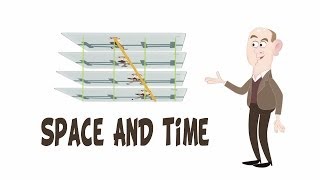(单词翻译:单击)
Space: it's where things happen.
空间描述事情在哪里发生。
Time: it's when things happen.
时间描述事情什么时候发生。
We can measure where things are and when things take place,
我们可以度量事情在哪儿,在什么时间发生,
but in modern physics, we realize when and where are actually part of the same question.
但是在现代物理学,我们发现时间和地点事实上是同一个问题的不同方面。
Because when it comes to understanding the universe,
因为当要了解宇宙时,
we need to replace three-dimensional space plus time with a single concept: four-dimensional space-time.
我们需要用一个概念来代替三维空间加时间,四维时空。
We'll explore and explain space-time in this series of animations. Animations? Yeah.
在这个动画系列里,我们将探索解释四维时空。用动画?是的。
Well, we're not very animated are we?
好吧,但我们并没有怎么动,不是么?
Sure we are! Look, I can go from here to here.
我们当然在动,看,我从这儿到了那儿。
Whoa! How'd you get from here to there? How fast did you go?
哇!你怎么从这儿到那儿的?你动得多快?
Did you run? Walk? Did you even go in a straight line?
你跑的还是走的?你是走的直线么?
Ah! To answer that, you'll need to make our cartoon physics look more like physics physics.
啊哈!要回答这个,你需要把我们的卡通物理变得更像真实的物理。
You'll need more panels. More panels, please!
你需要更多图画。请给出更多图画。
Okay, in each panel, Andrew's in a slightly different place.
好了,在每个图中,安德鲁在一个稍微不同的地方。
So I can see each one records where Andrew is at a different time.
每一张图记录了安德鲁不同时间的位置。
That's great. But it would be easier to see what's going on
非常好。不过我们能更简单地看清发生了什么,
if we could cut out all the hundreds of panels and stack them up like a flip book.
如果我们剪开数以百计的图画,然后堆在一起看的话。
Right, now let's flip through the book so that we can see one panel after another getting through 24 in every second.
就像手翻书一样。好,来让我们快速翻这本书。我们看到一个接一个的图画,每秒24张。
See! I told you it was an animation. Now you can see me walking along.
看!我说过这是个动画。现在你能看到我是怎么走过去的。
Drawing all those panels and putting them into a flip book is just one way of recording the way I'm moving.
画出所有图然后放在手翻书里,是记录我移动的一种方法。
It's how animation, or even movies, work.
这就是动画片,甚至电影的工作原理。
As it turns out, at my walking speed,
结果发现,以我的步行速度,
it takes two seconds to get past each fence post, and they're spaced four meters apart.
每两秒经过一个篱笆桩,桩子间距4米。
So we can calculate my velocity -- how fast I'm moving through space -- is two meters per second.
我们可以计算我的速度--我在空间移动的速度--就是每秒两米。
But I could've worked that out from the panels without flipping through them.
但事实上不需要翻动画面,我也可以从那些画面里面算出速度。

From the edge of the flip book, you can see all of the copies of the fence posts and all of the copies of Andrew
从手翻书的侧面,你可以看到篱笆桩的所有副本,还有安德鲁的所有副本,
and he's in a slightly different place in each one.
他在每个里面处在稍微不同的位置。
Now we can predict everything that will happen to Andrew when we flip through 24 pages every second,
现在我们可以预测以每秒24页翻动时安德鲁将会发生的事,
including his speed of motion, just by looking. No need to flip through at all.
包括他的运动速度,仅仅通过看,不需要翻动。
The edge of this flip book is known as a space-time diagram of Andrew's journey through, you guessed it, space and time.
这个手翻书的侧面就叫做安德鲁的行程的时空图,你猜到了,时间和空间。
We call the line that represents Andrew's journey his world line.
我们把代表安德鲁的行程的线叫做他的世界线。
If i jog instead of walking, I might be able to get past a fence post every second. He's not very athletic.
如果我用慢跑代替步行,我可能每秒通过一个桩。他不是那么有运动细胞。
Anyway, when we look at this new flip book from the edge, we can do the same analysis as before.
无论如何,当我们看这个新手翻书的侧边,我们可以做和之前相同的分析。
The world line for Andrew jogging is more tilted over than the world line for Andrew walking.
安德鲁慢跑的世界线比他步行的世界线更加倾斜。
We can tell he's going twice as fast as before without flipping the panels. But here's the clever bit.
我们不用翻画就可以知道他的速度是原来的两倍。但再机智点。
In physics, it's always good to view things from other perspectives.
在物理学中,多从其他角度看事情总是好的。
After all, the laws of physics should be the same for everyone or no one will obey them.
毕竟,物理基本定律对每个人都一样,或者说没有人能违背。
So let's rethink our cartoon and have the camera follow Andrew jogging along
重新审视这个卡通,让镜头跟随安德鲁一起慢跑,
as the fence posts approach and pass behind him.
篱笆桩一一接近又被超过。
Still viewing it as a flip book of panels, we don't need to redraw anything.
同样将其看做手翻书,我们不用重新画所有图画。
We simply move all of the cutout frames slightly until Andrew's tilted world line becomes completely vertical.
只是略微移动所有的画面,直到安德鲁的倾斜的世界线变成竖直的。
To see why, let's flip it.
为什么呢?来,翻起来。
Yes, now I'm stationery, just jogging on the spot, in the center of the panel.
没错,现在我是不动的,在固定点慢跑,一直在图画的中间。
On the edge of the flip book, my world line was going straight upwards.
在手翻书的侧边图里,我的世界线是竖直的。
The fence posts are coming past me. It's now their world lines that are tilted.
篱笆桩经过了我。现在桩的世界线是倾斜的了。
This rearrangement of the panels is known as a Galilean transformation,
这种图画的重新放置叫做伽利略变换,
and it lets us analyze physics from someeone else's perspective. In this case, mine.
它让我们从其他人的角度分析物理。在这个例子里,是我的角度。
After all, it's always good to see things from other points of view,
总之,多从其他角度看事物总是好的,
especially when the viewers are moving at different speeds.
尤其当观察者在以不同速度移动的时候。
So long as the speeds aren't too high.
只要速度不是太快。
If you're a cosmic ray moving at the speed of light, our flip book of your point of view falls apart.
如果你是一束以光速移动的宇宙射线,你看到的手翻书就跟不上了。
To stop that from happening, we'll have to glue panels together.
为了阻止这样的事发生,我们不得不把所有画面粘在一起。
Instead of a stack of separate panels, we'll need a solid block of space-time, which we'll come to in the next animation.
我们需要一个整块的时空来取代画面的堆积,我们将在下一个动画里解释这一点。


